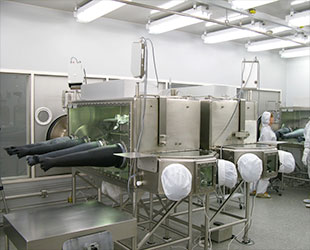 advertisements advertisements
|

|
Moon rock laboratory at NASA turns 25
NASA Johnson Space Center press release

The Lunar Sample Laboratory Facility at Johnson Space Center in Houston, Texas is celebrating its 25th anniversary. (NASA) |
July 22, 2004 — A truly unique facility that safely and securely stores and maintains a national treasure marked a key anniversary this month.
The Lunar Sample Laboratory Facility at Johnson Space Center in Houston, Texas, is NASA's chief repository for materials returned from the Moon during the Apollo era. Dedicated on July 20, 1979, the facility marked its 25th anniversary on Tuesday.
Between 1969 and 1972, six Apollo missions brought back 842 pounds of lunar rocks, core samples, pebbles, sand and dust. The spaceflights returned 2,200 separate samples from six different exploration sites.
"These samples and their study represent the strong, continuing science legacy of Apollo," said Dr. Carlton Allen, Manager of JSC's Astromaterials Acquisition and Curation Office. "New generations of researchers are using new generations of instruments to study the lunar rocks and soils. The Apollo missions ended over 30 years ago but, thanks to these samples, we continue to better understand the solar system and our place in it."
Eighty percent of the 842-pound collection, most of it still in pristine condition, is stored in the Facility. The two-story, 14,000-square-foot facility provides permanent storage of the lunar sample collection in a physically secure and non-contaminating environment. It cost about $2.5 million.
The lab allocates about 200 to 400 samples each year to scientists. Today about 90 lunar investigators worldwide, mainly from the university community, have samples. About 60 groups worldwide have been actively requesting samples for the past decade.
Interest in studying the samples remains high. While early studies focused on studying them to reconstruct the overall structure of the Moon, today scientists study the samples for two primary reasons: to conduct comparative planetology studies and to take advantage of recent improvements in analytical instruments primarily in the field of isotope geochemistry.
"We now are convinced that we have samples from Mars among the meteorites that have come to Earth," said Dr. Gary Lofgren, Curator of the Laboratory and a planetary scientist in JSC's Office of Astromaterials Research and Exploration Science. "We have samples from the Moon, and we have, of course, samples from Earth. And we have samples of meteorites that preceded the formation of the planets," explained Lofgren. "So we have samples from four different planetary entities. Scientists do what is called comparative planetology. Samples from one of those four entities are studied, and then those properties that were studied in one are studied in another to see how properties vary among planetary entities."
Isotope geochemistry involves studying the history of planets. Atoms of the same element, with differing atomic numbers, are called isotopes. Scientists study them to determine how old rocks are, and to follow minerals as they melt and crystallize. Some isotopic systems are based on very small quantities of elements that require recently developed instruments to analyze.
Recently, a new lunar mineral was named in honor of a scientist at the University of Pittsburgh in Pennsylvania. The mineral is named "Hapkeite" for Bruce Hapke who predicted many years ago that space weathering in the form of vaporization would be an important process on the Moon. The presence of this mineral is important for understanding the remote-sensing data collected on the Moon. Much has been learned by studying these lunar samples, but much more remains to be learned. Future potential return missions to gather more samples would be welcomed by scientists worldwide.
"We have samples from only six lunar sites," said Lofgren. "Just imagine if you had samples from only six places on Earth — there would be a lot you would not know. Specifically, we still don't understand the full breadth of the evolution of the Moon. We need a broader range of samples to date to capture the history of the evolution of the planet." |

© collectSPACE. All rights reserved.

|
|

|

|
